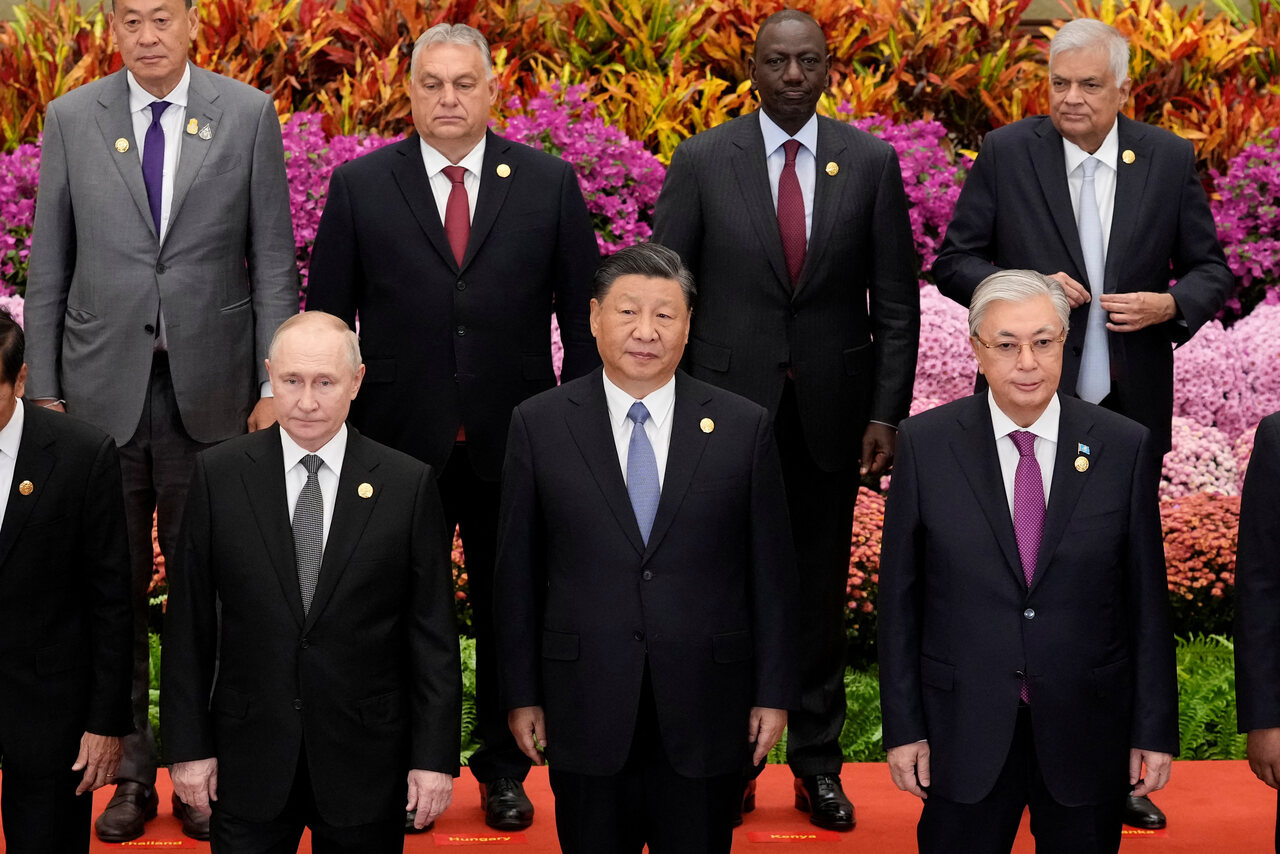China Transforms the Belt and Road Initiative
The 3rd Belt and Road Forum, held on 17-18 October in Beijing, highlighted the strengthening of the political component of the initiative. This means targeting developing countries that support China’s vision of the international order and share its anti-U.S. rhetoric. A central element of the Belt and Road Initiative will be China’s cooperation with Russia, whose leader was the guest of honour at the forum. In response, the EU and the U.S. can both expand their offers of economic and political cooperation to developing countries and point out the threats posed by the implementation of the initiative
 POOL / Reuters / Forum
POOL / Reuters / Forum
The year 2023 marks the tenth anniversary of the Belt and Road Initiative (BRI). Its main objective was to develop infrastructure connecting countries in Asia, Africa, and Europe, including through rail links and sea routes. Over time, China has recognised projects announced or underway almost all over the world as part of the BRI—according to the Chinese side, 130 countries are participating in the initiative. Data from the Chinese Ministry of Foreign Affairs, which is difficult to verify, show some 3,000 projects have so far been completed or are underway as part of the BRI for a total of around $1 trillion. The funds come mainly from loans from Chinese development banks.
The process of developing the initiative was reflected in subsequent forums held in Beijing in 2017 and 2019. The first was attended by 29 heads of state and government, the second by 36, including those from Greece, Spain, Italy, Poland, and others. Gradually, the initiative evolved towards cooperation with a smaller number of countries, including authoritarian regimes in Africa and Central Asia. At this third Belt and Road Forum, representatives of only 26 countries appeared at the highest level, including Kazakhstan, Serbia, and Argentina, as well as Hungary, which was the only EU member represented by a head of government. The forum’s main guest, however, was Russian leader Vladimir Putin, who also paid an official visit to China.
Belt and Road 2.0.
The proceedings of the Forum indicate that, within the BRI, the Chinese authorities have decided to strengthen cooperation in the digital and environmental dimensions, among others, while maintaining investment in the development of infrastructure connectivity. These areas were identified as key in his speech at the forum by China’s chairman Xi Jinping. He emphasised the need to expand transport links with the EU, including railways and the trans-Caspian corridor through the Caucasus. A new area of cooperation within the BRI is to be the Global Artificial Intelligence Governance Initiative. Through it, China seeks to strengthen its participation in the international process of regulating this technology, emphasising the sovereignty of states. Xi also announced an infusion of around $110 billion into Chinese financial institutions (the Silk Road Fund and two Chinese export-import banks) for new investment. This is in response to China’s declining capital commitment to the BRI, which is affected by, among other things, developing countries’ problems repaying existing debt.
The Chinese authorities see BRI as another instrument for cooperation with developing countries (of the Global South). This is due to their desire to polarise the international community in their rivalry with the U.S., and the negative assessments of the EU and the U.S. regarding the effects of the BRI. Cooperation within the BRI formula is to be accompanied by its participants’ support for an international order with less Western influence, the “One China principle”, and China’s new projects on the international stage: the Global Development Initiative (GDI) and Global Security Initiative (GSI). From this angle, the PRC will select those partners in the BRI with whom cooperation will be intensified. Xi sees the BRI as competition for initiatives vis-à-vis developing countries promoted by the EU (such as the Global Gateway) and the U.S. and its partners in the G7 (such as the PGII). China is exploiting the willingness of some EU countries (mainly Hungary) and candidate states (mainly Serbia) to cooperate in order to reinforce internal divisions within the Union, including limiting efforts to reduce its dependence on China. Consolidation of political cooperation within the BRI is to be served by the planned institutionalisation of the initiative, including the establishment of a Forum secretariat, as well as declarations of regular meetings at the level of heads of state.
The Russian Factor
Sino-Russian cooperation is to be at the heart of the new BRI. The Xi-Putin conversation held on the margins of the forum confirmed that Russia and China share strategic goals in competing with the U.S. and seeking changes in the international order. Putin’s presence at the forum was important for China as confirmation of Russia’s continued commitment to the BRI. It had already been identified in previous editions of the Forum as China’s most important partner in the initiative. Xi wanted to emphasise the importance of continued cooperation with Russia, as well as his support for Putin himself, not least through the special nature of the meeting with him (it lasted three hours and included a one-on-one conversation). To the same end, Xi pointed out during the forum the synergy between the Belt and Road and the Eurasian Economic Union promoted by Russia. China’s success was an agreement during Putin’s visit to import grain from Russia for the next 12 years, and is worth more than $25 billion. Despite Russian declarations, there was no breakthrough on the issue of the construction of the Power of Siberia 2 pipeline. The Chinese authorities pledged support for the development of transport routes passing through Russia, but also participation in the expansion of the trans-Caspian corridor, which competes with them. The visit did not indicate China’s readiness to increase its support for Russia in the war in Ukraine, such as military aid. However, political cooperation between the two countries aimed at polarising the international community and promoting a new global order was strengthened. This has taken advantage of Israel’s war against Hamas, in which both countries support the Palestinian terrorist organisation by demanding that the Jewish state stop escalating the conflict.
Conclusions and Outlook
The third Belt and Road Forum showed that the initiative in its original global concept based on an investment proposal addressed to all countries of the world has failed. Developing countries are now becoming the main partners in line with the implementation of the Global Development Initiative (GDI). Its stated aim is for China to cooperate with the countries of the Global South in, among other things, the digital and environmental fields in order to increase the prosperity of their societies. In this context, the addressees of the GDI and the BRI are countries that share China’s vision of the international order and do not mind the Sino-Russian cooperation that is crucial in the BRI. The institutionalisation of the initiative is expected to reinforce the image of China as a major partner of developing countries. It will also be one of the elements of subordinating the initiative’s participants to China’s strategic objectives.
Putin’s visit to China confirmed Russia’s deepening dependence on it, although the two countries’ cooperation still has limits. Xi, in return for symbolically honouring the Russian leader as the forum’s main guest, was able to reiterate China’s support for its initiative by its most important partner to date. At the same time, he did not specifically mention cooperation with Russia in the war in Ukraine, avoiding identifying China as a partner of the Russian Federation in the aggression. He did not confirm the implementation of new energy projects and hinted at the possibility of bypassing Russia in the BRI’s transport routes. In this way, he wanted to emphasise the autonomy of Chinese policy, including vis-à-vis its support for Russia.
The evolution of the BRI should prompt the EU and the U.S. to react. It is advisable to intensify economic and political initiatives vis-à-vis developing countries (e.g., in the framework of the Global Gateway or the PGII) and to cooperate on, for example, regulations and standards in international organisations, including advocating solutions relevant to developing countries in these institutions. Also important is an information policy indicating that China is using the support of the Global South to pursue Chinese strategic objectives, including at the expense of developing countries, for example, by increasing their economic dependence on China. The polarisation of the international community, linked, among other things, to the inscription of the Belt and Road within the framework of Chinese anti-Western concepts (e.g., GSI and GDI) will make it more difficult for the West in its relations with the Global South. Developing countries want above all to obtain economic and security benefits from the U.S. and/or the EU. The West, on the other hand, cannot change, for example, its policy of supporting Ukraine or Israel without damaging its strategic interests.
While maintaining economic cooperation with China, Poland should avoid activities that could be interpreted and used by China as evidence of support for the BRI, including participation in meetings or projects under this initiative. The economic benefits associated with, for example, the fees resulting from rail transport through Poland, are negligible and do not compensate for the political costs. Poland should support mechanisms in the EU for dialogue with the U.S. in the context of limiting the influence of China and its partners, above all Russia.





